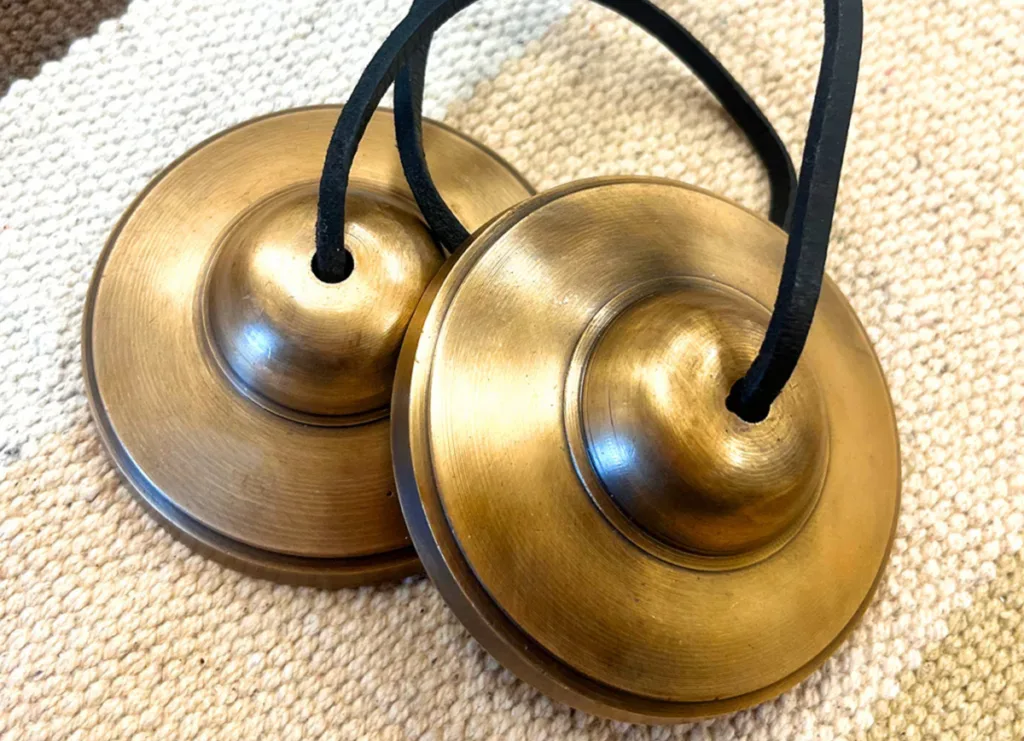
My introduction to Tingsha Bells was on the first five-day silent mindfulness retreat I attended in 1988. The bells announced the entire schedule of the day—wakeup time, each sitting and each walking meditation, yoga practice, meals and bedtime. When we heard the clear, dulcet tones of the bells, we knew it was time to move on to the next thing.
Also known as Tibetan chimes, Tibetan cymbals, or Kartals, Tingsha Bells are small, cymbal-shaped bells connected by a leather cord. Like cymbals, they sound when they strike each other. But unlike cymbals, they sound when the rims, rather than the flat surfaces, make contact. Tingsha Bells are also much thicker than percussion cymbals, giving the rims a rich sonority. The sound is a clear, high-pitched, long-ringing tone.
How to Use Tingsha Bells
Tingsha Bells originally come from Tibet. Often paired with variously pitched singing bowls, the bells are traditionally used in Buddhist meditation rituals. These days, yoga and meditation practitioners use them in a variety of ways. Following are some ways you can use these bells to enhance your yoga practice and teaching
Using Bells in Yoga and Meditation
- Beginnings and endings in yoga classes: Some yoga teachers like to begin and end their classes with the sound of bells. It’s a lovely way to settle students onto their mats, and to set an intention to turn awareness inward. The bells can gently bring people out of Savasana (Relaxation Pose) as well.
- Home practice: You need not be in a class setting to use Tingsha Bells to bookend your practice. Use them to mark the beginning and end of your own home yoga and meditation practice.
- Sound healing: Sound is vibration. You’ve probably experienced, more than once, how a thumping bass line in music can vibrate in areas of the body other than your ears. The ability of sound to vibrate within the body is one of the reason most of us love listening to music. In the yoga system, different pitches are said to resonate with each of our chakras (energy centers). Because of their higher pitch, Tingsha Bells tend to vibrate the upper chakras. Yogic sound healing rituals combine Tingsha Bells with singing bowls of various pitches to “tune” the chakras.
- Outdoor yoga and meditation: In the summer, I teach an outdoor mindfulness class at the local arboretum. In the class, we practice sitting and walking meditation. People often spread out during the walking period because there are so many beautiful places to practice. I use Tingsha Bells to notify people that walking meditation is over and it’s time to come back to our meeting place. Their high pitch cuts through other sounds and makes it easy to gather everyone together.

What a beautiful exploration of Tingsha Bells and their profound impact on yoga and meditation practices! As someone deeply involved in sound therapy and meditation, I’ve experienced firsthand how these sacred instruments can transform a practice. The high-frequency vibrations of Tingsha Bells indeed resonate with the upper chakras, creating an immediate shift in awareness that helps practitioners transition between different states of consciousness.
I particularly appreciate how you highlighted their versatility – from marking transitions in group settings to enhancing personal practice at home. In my experience working with sound healing, I’ve found that pairing Tingsha Bells with other instruments like singing bowls creates a complete sonic journey that addresses all energy centers in the body.
The historical context you provided about their Tibetan origins adds such rich dimension to understanding these instruments. Sound has been used as a healing modality across cultures for millennia, and it’s wonderful to see these ancient tools finding their place in contemporary wellness practices.
Thank you for sharing this insightful article that bridges traditional wisdom with practical applications for modern yoga teachers and practitioners!
Thank you so much for your lovely and informative comment. As an oboist, I’m well aware of the healing qualities of sound. There’s nothing like sitting in the middle of an orchestra playing Brahms or Mahler! I use Hugger Mugger’s tingsha bells in my mindfulness classes to start and end each sitting or walking meditation. I love listening to the entire sound, from the initial strike to when the sound trails off into silence,